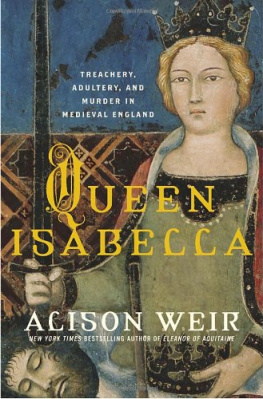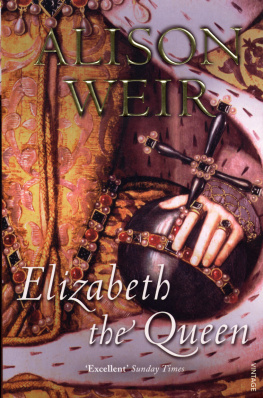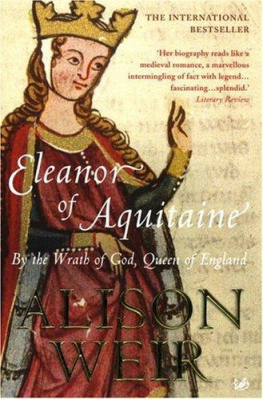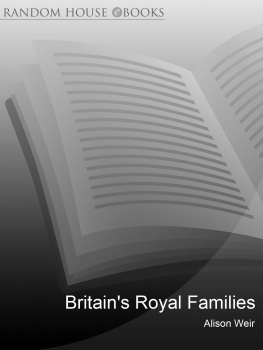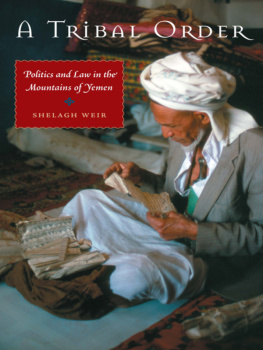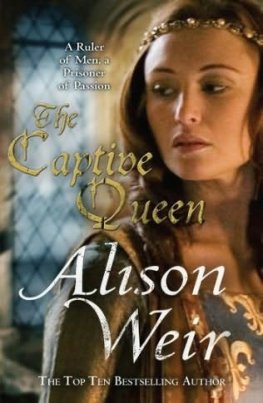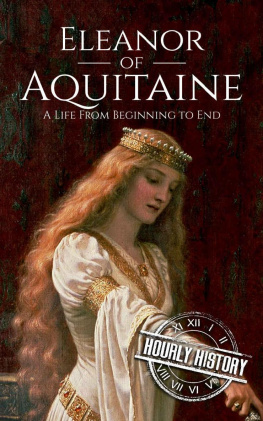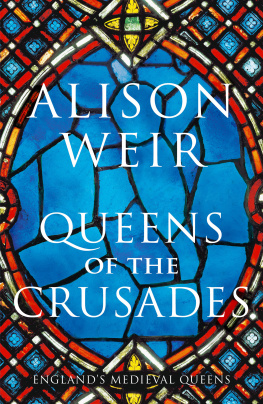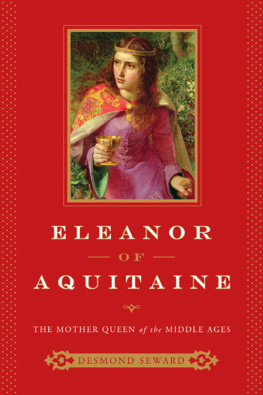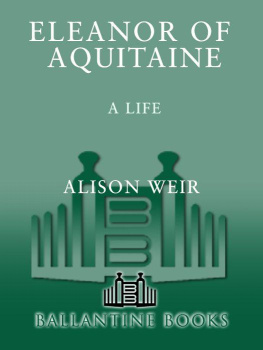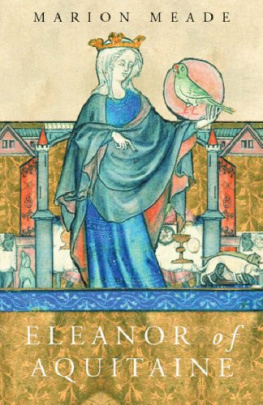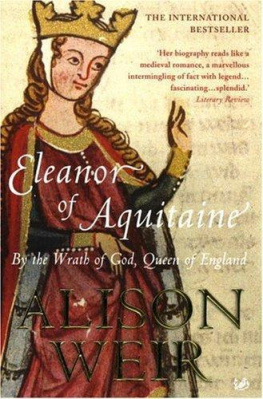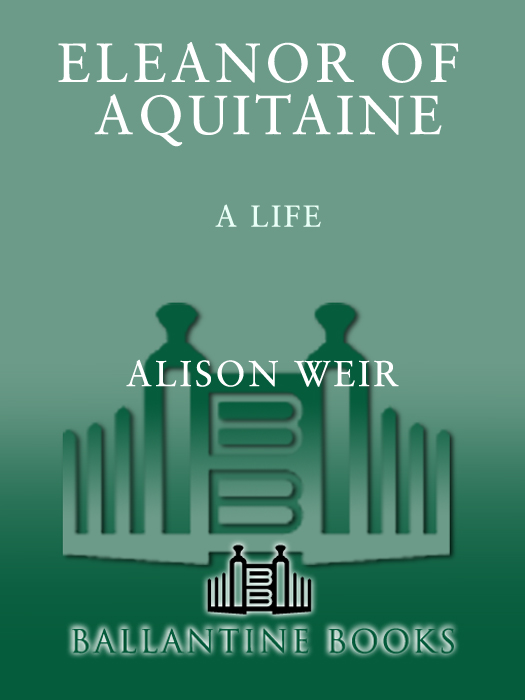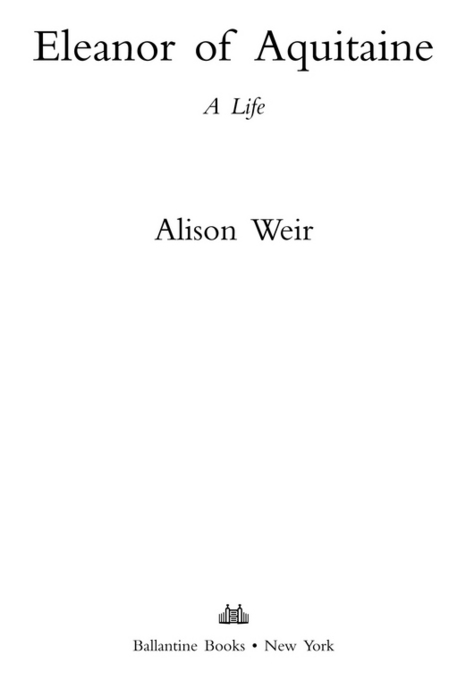Praise forEleanor of Aquitaine
Eleanor of Aquitaine was among the powerful rulers in Europe. In the sweeping pageant of Eleanor of Aquitaine Weir convincingly debunks some of the more salacious fables about Eleanors libertine ways.
The Boston Globe
As delicately textured as a 12th-century tapestry, royal biographer Weirs newest book is exhilarating in its color, ambition, and human warmth. The author exhibits a breathtaking grasp of the physical and cultural context of Queen Eleanors life Her account parades a sequence of extraordinary characters. Above all, there is the heroine, viewed clear-sightedly in all her intoxicating and imperious irresistibility.
Publishers Weekly (starred review)
One of the most fascinating women in not only English history but all of European history The authors well-written pagesas in her previous bookslead easily to a rich, deep, and accessible understanding of the topic.
Booklist
Alison Weir paints a vibrant portrait of a truly exceptional woman, and provides new insights into her life.
Koen Pacific
Weir provides the necessary checks and cautions against believing all we read, whilst enjoyably recording the gossip anyway. A balanced account, with myths, suppositions, and misunderstandings well ventilated.
Literary Review
A fresh biography of a remarkable woman.
Irish News (Belfast)
2008 Ballantine Books Trade Paperback Edition
Copyright 1999 by Alison Weir
Reading group guide copyright 1999 by Random House, Inc.
All rights reserved.
Published in the United States by Ballantine Books, an imprint of The Random House
Publishing Group, a division of Random House, Inc., New York.
B ALLANTINE and colophon are registered trademarks of Random House, Inc.
R ANDOM H OUSE R EADER S C IRCLE and colophon are trademarks of Random House, Inc.
Originally published in the United Kingdom in slightly different form by Jonathan Cape, an imprint of Random House Group, Ltd., London, in 1999. Subsequently published in hardcover in the United States by Ballantine Books, an imprint of The Random House Publishing Group, a division of Random House, Inc., in 2000.
A trade paperback edition was published by Ballantine Books, an imprint of The Random House Publishing Group, a division of Random House, Inc., in 2001.
eISBN: 978-0-307-83185-9
www.randomhousereaderscircle.com
v3.1
Contents
A Note on Names and Spellings
Different variations of the names of people and places occur in twelfth-century sources. For example, the names Matilda, Maud, and Mahalde are interchangeable, as are Alice, Aaliz, and Alais.
For the sake of clarity, I have used different spellings of the same name to identify different people. Eleanors daughter is called Alix, Richard Is betrothed of the same name Alys, and the Lord Johns betrothed Alice. All are accurate renderings. A similar differentiation has been used with the name Amaury/Aymer/Aimery. Louis VIIs daughter, often called Margaret in other works, is here referred to by the French version of her name, Marguerite.
Eleanor, who would have called herself Alinore, is referred to by the more familiar anglicised version of her name.
As in many other history books, William the Marshal is throughout referred to as such, even though he did not acquire his office of Marshal until 1199.
Although Eleanor was Countess of Poitou and Duchess of Aquitaine, I have occasionally used the name Aquitaine as a blanket term covering both her domains, although I have tried to differentiate between them wherever possible.
Many place names have changed since the twelfth century, and where appropriate I have given the modern name in parentheses. Some places no longer exist; wherever possible, I have attempted to discover their exact or approximate location.
Illustrations
Palais de Justice, Poitiers Roger-Viollet
William IX, Duke of Aquitaine. Manuscript illumination, fr. 12473 fol. 128 Bibliothque Nationale, Paris
Louis VII, King of France. Manuscript illumination from Grands Chroniques de France, fr. 2813 fol. 223 Bibliothque Nationale, Paris
Rock crystal vase, 12th c., from the Abbey of Saint-Denis, now in the Louvre Runion des Muses NationauxDaniel Arnaudet
Retable of St. Bernard of Clairvaux (detail), anon., 12th c., Museo de Mallorca, on loan from the Sociedad Arqueolgica Luliana
Count Geoffrey of Anjou. Enamel tombstone, c. 1152, Muse de Tess, Le Mans Giraudon
Eleanors seal, from a charter in the Archives de France Atelier de photographie du Centre historique des Archives nationales, Paris
Engaged capital, thought to portray Henry II and Eleanor of Aquitaine. The Metropolitan Museum of Art, The Cloisters Collection, 1934 (34.115.4ab)
Tomb of Matilda, daughter of Henry II, and Henry the Lion, Duke of Saxony, Brunswick Cathedral, late 12th c. AKG London
Effigy of Henry the Young King (detail), late 12th c., Rouen Cathedral Roger-Viollet
Effigy of Henry II (detail), late 12th c., Fontevrault Abbey AKG London
Effigy of Richard I (detail), 11991200, Fontevrault Abbey AKG London
Effigy of Berengaria of Navarre (detail), after 1230, Le Mans Cathedral Geoffrey Wheeler
Effigy of King John (detail), c. 12251230, Worcester Cathedral Geoffrey Wheeler
Mural from Sainte-Radegonde, Chinon, c. 1196 By courtesy of Les Amis du Vieux Chinon
Effigy of Isabella of Angoulme (detail), mid 13th c., Fontevrault Abbey Geoffrey Wheeler
Effigy of Eleanor of Aquitaine (detail), c. 1204, Fontevrault Abbey AKG London
The tombs of the Plantagenets in the Abbey of Fontevrault Bildarchiv Foto Marburg
Maps
The Angevin Empire in 1154
Europe and the Holy Land in the Twelfth Century
England in the Twelfth Century
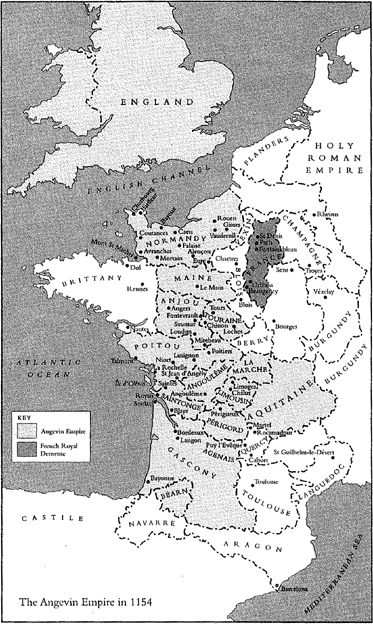
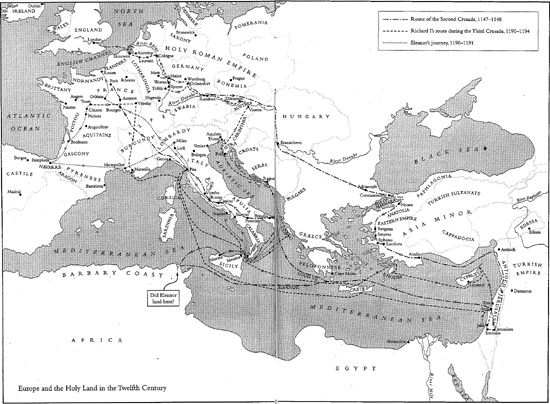
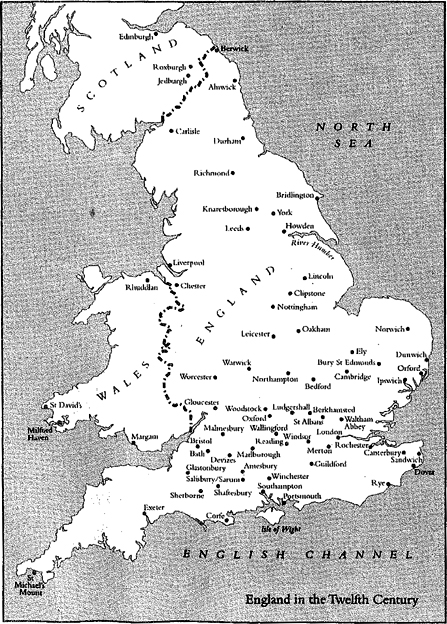
Preface
When, after completing several books on the late mediaeval and Tudor periods, I suggested writing a biography of Eleanor of Aquitaine, it was put to me that it would be impossible for a biographer to do justice to a woman who lived eight centuries ago: that so few of her utterances or letters have come down to us that I would never be able to bring her to life as a real person to whom my readers could relate.
It was a valid point, because for the earlier mediaeval period, the sources that so vividly illuminate the characters of the Tudorsdiplomatic reports, letters, memoirs, diaries, biographiesrarely survive. And there is a perception, common among those who are more familiar with the later period, that such monkish chronicles as we do have are mostly credulous, biased, and ill informed. In some cases, this is indeed so, particularly in respect of the period covering the early years of Henry IIs reign, for which there is a paucity of contemporary sources; but there are a considerable number of English chronicles of outstanding quality for the latter part of the twelfth century.


